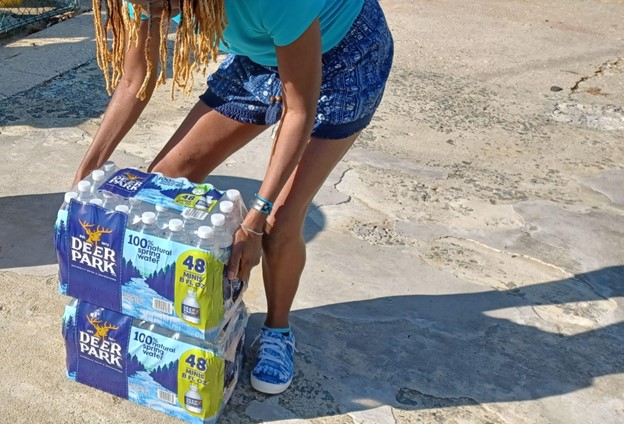Like in Flint and Jackson, the residents of Baltimore, especially those living in underserved communities around the city, are experiencing environmental injustice when it comes to their water.
In the past few weeks, over 1,500 residents of Baltimore City found themselves scrambling to find clean water after an E. coli contamination in parts of West Baltimore’s water supply. With already crumbling water infrastructure and a slow response from Baltimore’s mayor, Brandon Scott, many residents now fear that a future crisis can only be worse. It is clear that the bandages being placed over Baltimore’s gaping infrastructure wounds will no longer hold.
On September 5, 2022, West and Southwest Baltimore residents awoke to a boil advisory following the discovery of an E. coli contamination. Hundreds swarmed grocery stores to purchase water so that they could drink and bathe. The contamination left over a thousand residents, families, businesses, hospitals and schools without a basic need: clean water.
The contamination has been an event to sweep headlines, allowing Baltimore to join the ranks of Flint, Michigan and Jackson, Mississippi in water disasters. Like these other cities as well, this event was not surprising for Baltimore. Poor infrastructure has plagued poor communities of color, especially Black communities, in Baltimore City for decades. This is only the latest example.
The E. coli water crisis has not been the first effect of weakening infrastructure, nor will it be the last. Just earlier this year in Baltimore, a massive sinkhole struck the heart of North Avenue. The sinkhole, caused by an overwhelming influx of rainwater into a tunnel which The Baltimore Sun notes was “built during the Presidency of Teddy Roosevelt,” created a hole 25 feet deep and demolished three homes in the area.
With climate change worsening our weather and weakening the strength of our natural ecosystems, residents can only expect more environmental disaster to follow unless infrastructure is entirely remodeled.
In 2019, Baltimore residents received more than a 30% hike on their water bill because of long needed plans to address the growing damage in the city’s water and sewer systems. This sudden increase proved financially harmful to more than 60% of Black Baltimore residents, the majority of whom were living in the very neighborhoods where the consequences of poor infrastructure were most prevalent and obstructive to their day-to-day life.
Harold Thompson, a maintenance worker living in West Baltimore, expressed his frustrations with Major Brandon Scott’s response to the city’s most recent water crisis: “they got us paying for contaminated water. Can you believe that? That man, Brandon, has the nerve to come on live TV and say that he handled it correctly.”
Thompson continued, “how? This is something that has been going on for a while. It ain’t no way this just popped up.”
Anne Vincent, a stay-at-home mother in Baltimore, like many other residents, encountered difficulties obtaining enough water after the advisory was sent out. She said, “all of the water at Sams, Mars, and Giant were gone. People were taking cases on cases. The water we could get was an arm and a leg.”
She talked about the city’s response to the shortage, handing out water bottles to residents on the street, saying it was “not enough to bathe, wash, or do anything.”
She concluded with disbelief at the handling of the crisis: “our kids and seniors need water. How are they supposed to get water? We can’t even get basic needs.”
Besides concerns about management of the contamination crisis post-advisory, residents have also expressed concerns that city officials did not inform residents soon enough of the issue in the first place.
Mayor Brandon Scott has been on record, saying on the subject, “there was no bungling of communication. Every rule was followed.” However, many still feel wronged and rightfully so.
Vincent detailed her concerns, saying, “we are up here drinking contaminated water for God knows how long. How much contaminated water did these schools, hospitals, and businesses use without knowing?”
Baltimore City Councilman Eric Costello, representing the city’s 11th district, was recently interviewed by Fox45 News about Mayor Scott’s response. Costello commented on Mayor Scott’s lack of immediate action as well in handling the announcement, stating, “there is not an excuse for that lack of communication. That gap of nine hours after Labor Day. That gap should not exist.”
Bryce Stewart, a junior UMBC Economics major, lives in South West Baltimore. He reflects on the day he spent before the city’s advisory announcement, saying, “I went to a get-together for Labor Day and then I found out about the contamination.” When he arrived home to the announcement house later, he says his group “couldn’t do anything but hope neither of us got sick.
He commented on the depths of the issue: “I don’t blame one person for this. The water crisis is structural and systemic. I can only hope that this will be a wake-up call.”
Vincent was not as hopeful, remarking, “this will keep happening. I’m just stocking up – If it isn’t water, it’s gas or the pipes. Baltimore is a ticking bomb on a merry-go-round, and it’s time for someone to step up and stop the ride.”
With Baltimore’s infrastructure on a steady decline, only worsened by the impact of climate change, it is hard for residents to see the light at the end of the tunnel.
There is some promise. Mayor Scott has invested in the city’s first Office of Infrastructure with plans on implementing more water affordability programs in the near future.
However, Baltimore residents are trusting less in the words of their governing officials and more on the action and advocacy they see in their own communities. Black communities especially have stood on the front lines, doing the work the city should be doing to protect the people most vulnerable to these disasters.
Refusal, on part of city leaders, to fully address and prevent these issues results in a failure to protect Baltimore communities and continues a cycle of environmental injustice.

